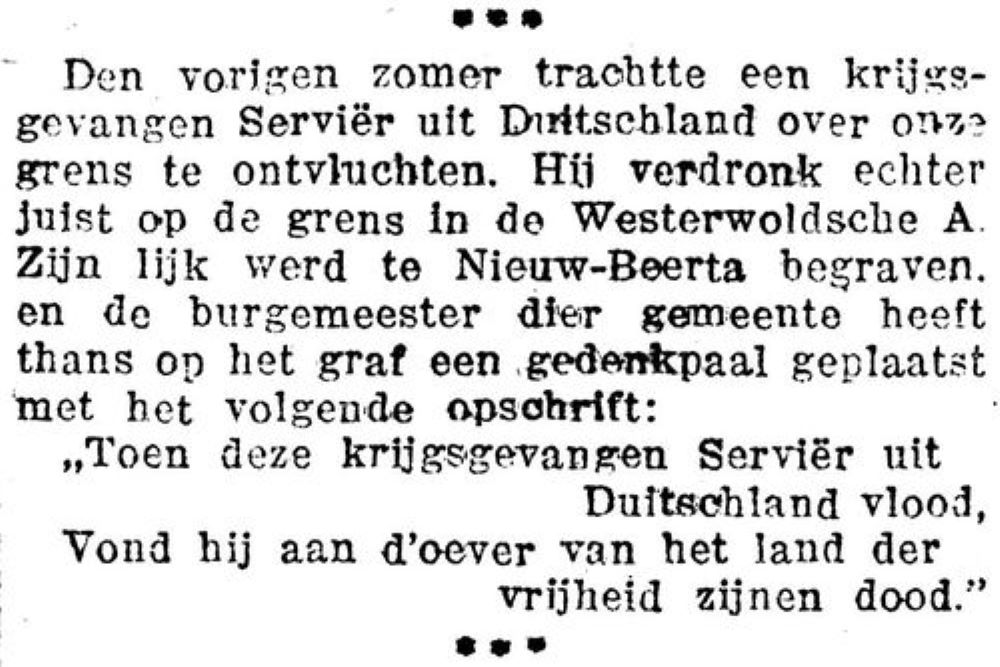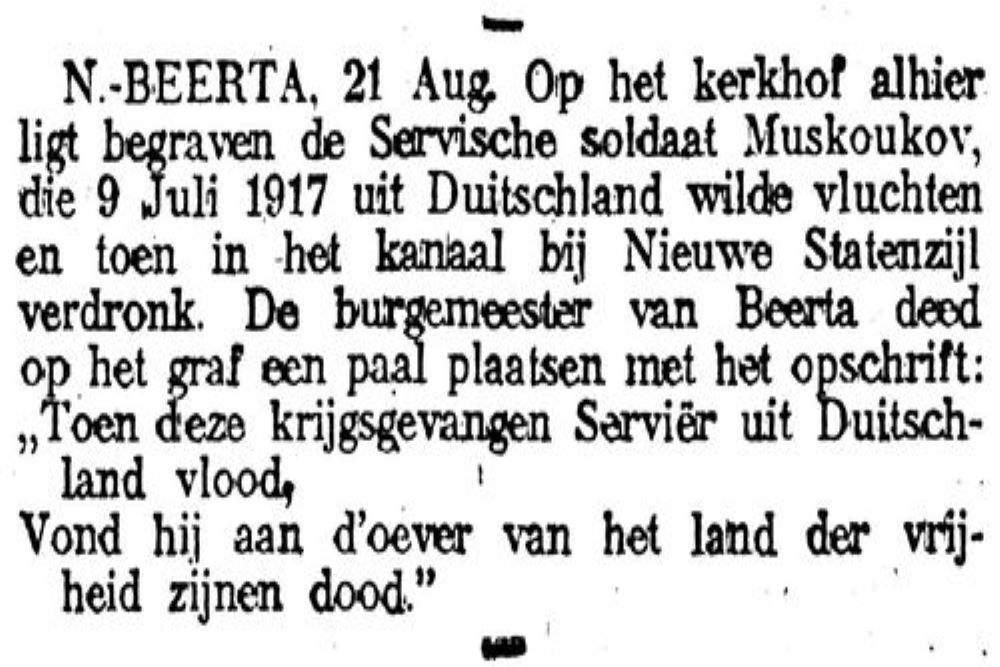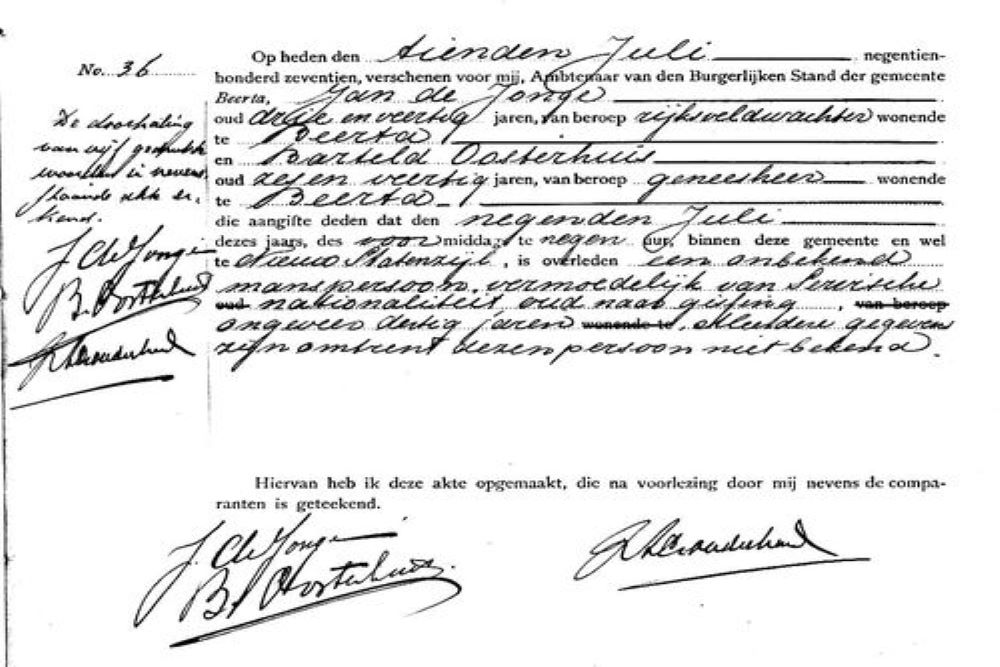War Grave Serbian Prisoner-of-War
On the Municipal Cemetery in Nieuw - Beerta is a war grave of a Serbian prisoner of war. His surname is Muskoukov, and he drowned near Nieuw Statenzijl, during his flight from Germany on July 9, 1917.
Photo 2: Article Nieuwsblad for Friesland from 23-8-1918
Photo 3: Article Nieuwsblad van het Noorden of 21-8-1918
Photo 4: Death certificate Municipality of Beerta
There were Serbian war graves in several places in the Netherlands. Only this one remains. The grave has no headstone.
On July 28, 1914, World War I broke out after Gavrilo Princip, a Bosnian Serb nationalist, assassinated Archduke Franz Ferdinand of Austria in Sarajevo a month earlier. The First World War lasted until November 11, 1918.
The Netherlands was neutral during this Great War, but by the fifth convention of The Hague, signed at the second peace conference in 1907 in The Hague, became the scene of the exchange of prisoners of war. Already during the war, food, shelter and relative freedom were offered to soldiers of the warring parties who managed to reach the neutral Netherlands.
On July 2, 1917, there was an agreement between Germany and England to accept 17,000 prisoners of war in the Netherlands. As a result, there were already thousands of refugees and prisoners of war on Dutch territory during the war.
These POWs and civilians were housed in various camps all over the country. After the war, which ended on November 11, 1918, the port of Rotterdam (but also other ports) was used to repatriate these prisoners of war. According to newspaper reports from January 1919, 222,347 prisoners of war had entered the Netherlands since mid-November, of which 202,250 had left our country. Among them were 4316 Serbs, of which 1160 had entered the country via Enschede. These Serbs had fought together with the Allies and would now return to their homeland via the Netherlands. Until January 15, 1919, 130 Serbs had left the Netherlands in this way.
In January 1919, however, the Spanish flu broke out and this group of Serbian prisoners of war, which still consisted of 4186 moons, who had already been extra weakened by more than four years of mobilization and war, was not spared. Before the First World War, the Serbs had already been through two Balkan wars. Between January 11 and February 7, 1919, so in four weeks, 87 Serbian soldiers in the Netherlands died - not from war but from the Spanish flu. The 5 other Serbs died before January 1919 from various causes.
All Serbian soldiers were buried in the Netherlands, namely in Barneveld (Garderen 29), Nijmegen (21), Lonneker (Enschede: 17), Dordrecht (15), Hengelo (3), Rotterdam (2), Borger (2) Amersfoort (1 ) and New Beerta (1)). From the 1920s, the (then) "Kingdom of Serbs, Croats and Slovenes" began to concentrate its war graves on places where many Serbs died, such as Zeitenlik and Vido in Greece or Olomouc and Jindřichovice (the site of the Austrian concentration camp Heinrichsgrün) in the Republic of Czechoslovakia.
Plans were also made to concentrate the remains of the Serbs who had died in the Netherlands. In accordance with Dutch law, something had to be done to ensure that the graves were not cleared: a grave may be cleared if no one comes forward to claim the grave within the legal term of 10 years.
That is why the Consulate General of the Yugoslav Kingdom in Rotterdam contacted the Dutch authorities in the 1930s to exhume the graves and transport them to the Serbian Field of Honor in Thiais near Paris. The Consulate General contacted the municipalities where the Serbs were buried to organize the excavations and also the Yugoslav Legations in Brussels and Paris to ensure proper transport by rail via Roosendaal.
In November 1937 it became clear that there was not enough space in Thiais, so it was decided to transfer the remains to the Serbian mausoleum in Jindřichovice, Czechoslovakia. Two inspectors were sent to the Netherlands from Yugoslavia to coordinate this. At the beginning of May 1938, 88 bodies were exhumed and transported to Nijmegen, where they were re-coffined in lead coffins.
The transport to Germany departed in the morning of May 18, 1938 from the Rustoord cemetery in Nijmegen. On the Dutch-German border near Wyler/Kraneburg, the 88 aircraft were handed over to the Germans, who received them with military honours. From there the transport continued to the mausoleum, where 88 of the 92 Serbian soldiers who died in the Netherlands found their final resting place.
Of the 4 graves that were not cleared in 1938, only the grave in Nieuw-Beerta is known to still exist. One grave in Rotterdam was probably cleared before 1938 and something similar seems to have happened in Borger.
Do you have more information about this location? Inform us!
Source
- Text: Bert Deelman
- Photos: Bert Deelman
- Gemeente Oldambt - Team Begraafplaatsen
- Secanje.nl
Nearby
Monument
- War Memorial Nieuw Beerta - Nieuw Beerta
- Commemorative column "Route of the Persecution" - Bad Nieuweschans
- Memorial "The Last Glance" - Bad Nieuweschans
Cemetery
- Dutch War Graves Nieuw Beerta - Nieuw Beerta
- Dutch War Graves Municipal Cemetery Bad Nieuweschans - Bad Nieuweschans
- Commonwealth War Graves Bad Municipal Cemetery Nieuweschans - Bad Nieuweschans
Remembrance Stone
- Stumbling Stone Molenlaan 14 - Nieuw Beerta
- Stumbling Stone Oudeweg 3 - Drieborg
- Stumbling Stone Drieborg 36 - Drieborg






